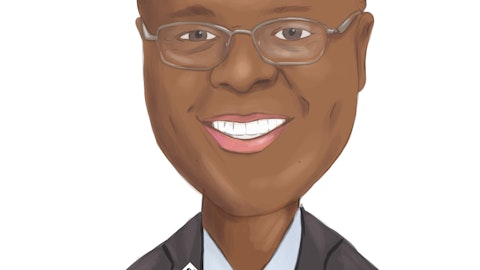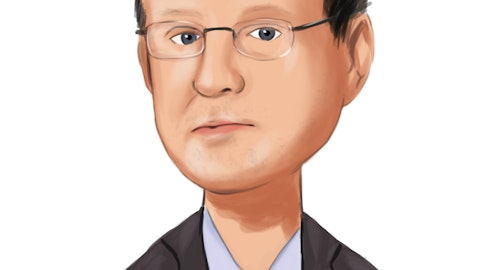Scott Kavanaugh: Well, I’ll answer this, and Chris can step in. But Trust is, in my opinion, one of the most important aspects. As you know, most trust companies are not on the West Coast. They’re on the East Coast and banking sectors. And when it comes to First Foundation Advisors probably about 90% of our assets are held at Charles Schwab, which is an extremely strong institution. I’ve said in the past, we’re part of their SAN program and the SAN program is a program that you’re basically allowed as a registered investment adviser to go into select offices of Charles Schwab. It’s prenegotiated with Charles Schwab, which branches you’re allowed to go into. There’s off matrix and other types of things. But when you look at across the universe of RIAs, every RIA is all pretty much the same, with the exception of what I feel is a very select offering for us.
We’re one of only a few trust companies, solutions for the Charles Schwab, and we’re really trying to exploit that as well as continuing to get out to professionals. As you know, a trust department that starts, which our trust department is 15 years old, same as the bank, has grown tremendously because of First Foundation Advisors having a strong presence with CPAs and attorneys in the Orange County marketplace. We’ve now expanded that across all of California. We’re getting into Florida and Texas. And I believe as we — some of our referrals have been coming from Charles Schwab, and we’ve noticed that the activity is picking up as a solution. And we believe that, that’s probably the best ringed for both First Foundation Advisors and the trust department.
Joe DePillo: So I’ll speak more a little bit on that and provide a little additional color. Having grown up in this platform, I can tell you that we have 55,000 bank clients that, frankly, have deep pockets and a deep relationship in Nexus to our brand. The stickier they are, the better it is for the brand. That means that trust clients and FFA existing clients take advantage of the wealth planning services and that wealth planning services creates new business banking opportunities for the bank. And it’s an ecosystem that I think in some ways we can continue to still expand and exploit particularly as it relates to our data warehouse and the vast capabilities of the information that we have with every single one of our clients.
One of the key initiatives that I’m really looking at doing is being a better partner with the advisor side, on the bank side to work more collaboratively as we push forward. And I think that those conversations could actually be very, very fruitful, not say that they haven’t been historically. But certainly, with the amount of information and the amount of product offerings that we have, it’s an exceptionally broad brand that frankly has things that larger banks can’t compete with, certainly from the value proposition of service.
Scott Kavanaugh: One of the things, I think, David, that we have not done well is penetrate ourselves, especially through the branch network. And recently, Rick Keller, our Chairman of the Board, in conjunction with our bank employees reached out to the 20 largest clients in our Irvine branch. And as a result of that, just by Rick speaking to these 20 individuals, and it was really about what the economy is doing his typical what he would do with any client or a group of people talking about what the Fed is doing, what’s happening in the economic cycle, etcetera, etcetera, generated something like $8 million to $10 million of new deposits, which is not even what you would expect to happen and he got additional dollars for First Foundation Advisors. So we’re going to — I think one of the things that Chris just touched on is we need to do a better job of working our own brand, and that’s what you’re going to see on a go-forward basis.
Joe DePillo: And I’ll leave it with one last thought on that topic. Overall, $68 trillion is set to exchange hands. We are well positioned to facilitate that with not only our existing clients, but with new ones. So there’s a lot to grab for there, both inside and outside the company.
Operator: Our next question comes from Gary Tenner from D.A. Davidson.
Gary Tenner: I wanted to shift over a little bit on the deposit side of things. Scott, can you tell us what the what the spot rate was on deposits at the end of the quarter. I don’t know if I saw that in your deck at all anywhere.
Amy Djou: Including noninterest-bearing, it was 147.
Scott Kavanaugh: Including noninterest-bearing, it was 147.
Gary Tenner: That was as of 12/31?
Scott Kavanaugh: Yes.
Gary Tenner: Okay. Okay. So in terms of customer service fees, they didn’t go up quite as much as we would have thought given the rate hikes in the fourth quarter. So — is part of that related — was there a decline in the bearing deposits that are ECR deposits in the fourth quarter? Was that part of the decline in overall noninterest-bearing deposits in the quarter?
Scott Kavanaugh: Well, we’ve stated in the past that MSR deposits, in particular, are always on a low around the December time frame, and that’s due to tax and insurance payments going out with our MSR clients. And it’s also in the April time frame. So right now, you should see deposits picking back up with those MSR clients. I will also add that 10/31 exchange has probably decreased a little bit due to the activity of transactions slowing. But right now, the next probably 4 months, you should see a pickup in deposits. But yes, it’s considered a low point in the fourth quarter.
Gary Tenner: Okay. And then in terms of the brokered deposits that you added in the quarter, can you talk about kind of — tell us what the yield or the rate on those and kind of a in terms of maturity?
Scott Kavanaugh: We’ve kept all our maturities under — majority, let me say, 90% under 2 years. So we’re funding really more on the short side. It’s really our belief that the Fed is way more towards slowing increases on the Fed cycle. And we don’t want to, at the wrong moment, go extremely long term on CDs or other types of broker deposits. So they’re all really more, I would say, probably 90% of them are 2 years and under.
Gary Tenner: Okay. Great. And then last question. Just in terms of — you talked about the expense or some last quarter, I think, some expense focus. Obviously, the reversal of some incentive comp in the fourth quarter related to the departures. Separate from customer service deposit or customer service go up a bit more as the Fed raises more in the first quarter, any opportunities to offset that NIM compression and NII with lower expenses or anything else to be there beyond what you’ve done?
Scott Kavanaugh: Well, it really pains me to say this, as a person, it’s not something that anybody wants to do, but we did just go through a pretty significant round of layoffs. I’m not happy that that’s the case. But as the CEO of a publicly traded company, that’s would also forces us to consider all alternatives. And we will continue to look operationally to see where we can continue to provide call saves. I was trying desperately not to have to go there, but we, like I think many other institutions, have had to go through that.
Gary Tenner: Was that — so was there any impact there in the fourth quarter from whether it be severance or otherwise? Or is that going to be reflected in the first quarter, Scott?
Joe DePillo: Yes. Dan, the severance are included in the fourth quarter. And so we — I mean, it’s not much. Basically, it’s a severance is offset with what the other accruals that we reversed due to the exit of executive management.
Scott Kavanaugh: Yes, that breakdowns in the non-GAAP tables.
Joe DePillo: Did you hear that, Gary? The breakdown…



